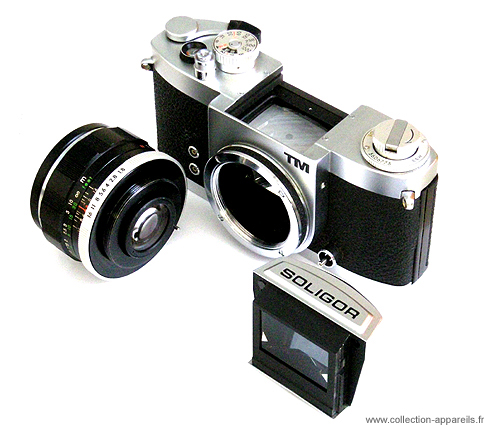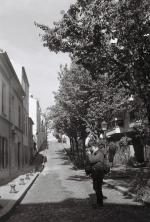|
Soligor TM |
Manufactured or assembled in Japan from 1974 to (After) 1974.
Index of rarity in France: Infrequent (among non-specialized garage sales)
Inventory number: 11492
See the complete technical specifications
Chronology of cameras Soligor
First, a Miranda camera has a feeling of quality and robustness imposed by the materials used, finishing, and the weight of all, on this point, and with its 700g (including the plain glass prism 120g, no lens mounted), the TM is no exception to the rule.
Yet the Soligor TM is an exception among its congeners, because it is one of the rare models not equipped with dual mount baïonette / thread typical and dear to the manufacturer.
Among the brand's other models, it is a "low end" one, as it doesn't feature a self-timer, like its older brother the Sensomat RE from wich it is derived did. The uncoupled cell powering with DOF test button seems to betray the adaptation made with this mount on an existing model.
As its name is supposed to indicate, it is equipped with threaded mount M42x1, which offered a wider range of broader lenses back in the days, than the Miranda mount did.
It is therefore a 24x36-SLR with cloth curtain shutter, TTL metering, and interchangeable viewfinders.
Despite a massive look, the sound of the TM is rather discreet for a SLR, the more astonishing, is its virtually silent shutter, whatever the speed. The end of the mirror's run is cushionned by spring legs wich then latches the curtain run.
The sensor is behind the mirror at the two lower thirds of the picture, except the center, for optimum brightness on the microprisms, it only need one SR 44 to work.
The mirror has no manual lifting, one need to arm to turn the meter on, then triggering the DOF test button, which maintains self, just push once more to reopen diaphragm, the lens can therefore remain closed until the shot.
Once the diaphragm is set, the diaphragm closes only when the mirror gets up, then immediately reopens shooting.
The bright viewfinder covers almost the entire field, the microprisms are very (too) accurate, and indicates the metering results +/ok/- by a needle, no indication graduated the +1/-1 way, but its results are fairly consistent.
The speed range proposed by the TM, fairly large (B, 1-1000) is fully available for 100 ASA, higher or lower sensitivity setting causes lost of one speed on one side or another (for 200 no more B, for 50 no 1/1000), which remains only little embarrassing, since one can cheat, testing light with 100ASA setting and then opening or adjust speed according to the sensitivity of the film used.
The shoe accessory of the TM-whatever variant (see below) is not synchronized, a flash with PC cord is needed, two connectors are then available for mag, and electronic flash. The speed synchronization is between the 30th and 60th (probably 1/45).
Around the crank is a reminder that can be placed on B & W, color positive or negative, the meter doesn't seem to be affected by this setting.
Different screen models were proposed, but only changeable by a technician, in a workshop, for against, several finders have been proposed, folding waist level finder, vertical finders at various magnifications, prism finder with CDS cell (for optional TTL measure on earlier models).
The cover ever-ready in real leather, dark red velvet interior, although marked Soligor, seems made from another brand, a logo "K" on its back, it is attached by a screw thread taken in the bottom and behind it is possible to screw a tripod (1/4 ").
The many avatars of Miranda TM:
The TM Miranda had two variants, each distributed in three distinct brands, Miranda, Soligor, and Pallas. On the end of production, the second option has been renamed TM II for Soligor and Pallas.
The standard lens was a 50mm 2.8 for Miranda, and 1.8 for Pallas and Soligor.
Among the differences, we will not detail the markings on the prisms, specific to each brand, nor those on the lenses, but we'll point the main functionnal differences.
The background color of the frame counter and sensibility setting seems pretty random.
The back lock is external on the early models, the latter ones open by pulling the handle at it's best.
The removable accessory shoe is clipped onto the crank, later it is at the top of prism, but always without contact.
The prism locking system is released by pushing a little button on older ones, and by rotating the dial with the film type reminder index, at the winding crank base, on the last ones.
Sensitivity tops out at 1600 ASA on the former, while the last ones can go up to 6400.
The model presented here is a Soligor TM second variant. When I got it, I think he did not have more than 25 rolls and the 50mm-1,8 had apparently ever been unmounted since the factory assembly.
It was in almost new condition, apart from a lubricant leak inside the front lens, which was easily cleaned.
Also, it lacks the DOF test button (probably lost), and this DOF test is not reversible, it doesn't reopen the diaphragm when pushed a second time, perhaps it is a spring defection or a variant.


Interesting links or bibliography :
| Sur mes-appareils-photos.fr, suggested by Eric Carlhan |
Add a link or element of bibliography, a picture taken with this camera, a picture of box or an ads about this camera
Your photos taken with the same camera:
Cameras from Ebay France (Soligor) (Uploaded each 3 hours)








